
Hannah Zheng
Undergraduate in BSc Nutrition
Jump to:
- What is Vitamin K?
- Vitamin K deficiency
- Different types of Vitamin K
- Health Benefits
- Health Claims
- Best sources of Vitamin K
- Daily requirements and intake
- How to take Vitamin K
- Signs and symptoms of deficiency
- Risks and side effects
- Interactions - herbs and supplements
- Interactions - medication
- Summary
- Related Questions
Vitamin K is not often mentioned, and perhaps is overlooked regarding its importance in our general health and wellbeing.
While studies have shown that vitamin K has a crucial role in
- Coagulation
- Bone health
- Cardiovascular health
new and emerging research is showing that there is an intricate relationship between vitamin K, vitamin D and calcium.
What is Vitamin K?
Vitamin K, a fat-soluble vitamin plays a crucial role in several bodily functions. It especially has key roles most notably in blood clotting, bone health and cardiovascular health.[1]
There are two forms of Vitamin K:
- Phylloquinone (Vitamin K1)
- Menaquinone (Vitamin K2)
The differences between these two forms are discussed later in the article.
History behind Vitamin K
In 1929, a Danish scientist, Henrik Dam studied the cholesterol biosynthesis in chickens being fed a fat-extracted diet. He observed an unexpected hemorrhagic disease which was caused by a deficiency of a previously unrecognised fat-soluble substance in the diet.[2]
He named this new substance Vitamin K for Koagulation Vitamin.[2,3]
Vitamin K deficiency
Vitamin K deficiency is also known as hypovitaminosis K. Hypovitaminosis K is uncommon in healthy adults because vitamin K is rapidly broken down and excreted by the body, making toxicity extremely rare, even with high intakes.[4]
However, a deficiency can still occur under certain conditions, which will be discussed in more detail below. The main reasons being due to
Who is most at risk of Vitamin K deficiency?
Newborns and infants
Vitamin K deficiency bleeding (VKDB) is a condition that is due to vitamin K deficiency, most commonly affecting newborns and infants.[6,7]
There are three types of VKDB in newborns/infants:
- Early – First 24 hours of life, occurs due to medications that the mother has taken (anticoagulants, anti-seizure drugs, etc).
- Classic – 1 to 7 days of life, occurs due to low concentration of vitamin K in breast milk, especially if vitamin K supplementation was not received.
- Late – 2 weeks to 6 months of life, typically occurs in exclusively breastfed infants/newborns who did not receive vitamin K at birth.[8]
Breast milk is low in vitamin K, and this nutrient doesn’t transfer well from the mother’s placenta to the baby. Newborns also have underdeveloped livers and do not produce vitamin K2 on their own for the first few days, increasing their risk of deficiency.[9]
Breast milk is low in vitamin K
Studies have shown that exclusively breast-fed infants are more susceptible to the development of Vitamin K hypovitaminosis than formula-fed children.[10]
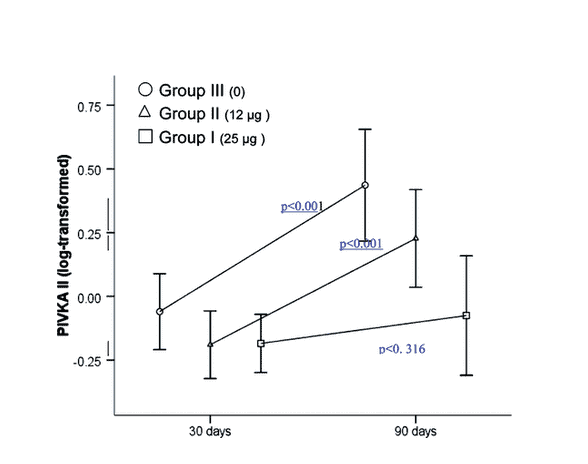
Group I: 25mcg of vitamin K, Group II: 12mcg of vitamin K, Group III: Placebo
High amounts of PIVKA-II (protein induced by vitamin K absence) is a result of vitamin K deficiency.[11]
Health issues and taking medications
Individuals with gastrointestinal disorders, for example, Crohn’s disease, celiac disease, and ulcerative colitis are more prone to vitamin K deficiency as the ability to absorb Vitamin K is impaired.[4,12]
RELATED — Coeliac Disease: Testing, Treatment and Diet
Prolonged use of antibiotics (lasting more than 10 days) can lead to vitamin K deficiency. This occurs because antibiotics disrupt the gut bacteria responsible for producing vitamin K, reducing the amount available for absorption by the body. Individuals on long-term antibiotic therapy are, therefore, at a higher risk of developing this deficiency.[13]
Similarly, those taking anticoagulants like warfarin are also prone to vitamin K deficiency. Warfarin works by interfering with vitamin K metabolism, thinning the blood and preventing clot formation, but this also reduces the body’s ability to use vitamin K effectively.[14,15]
Severe liver disease
The liver plays a crucial role in producing clotting factors that rely on vitamin K.
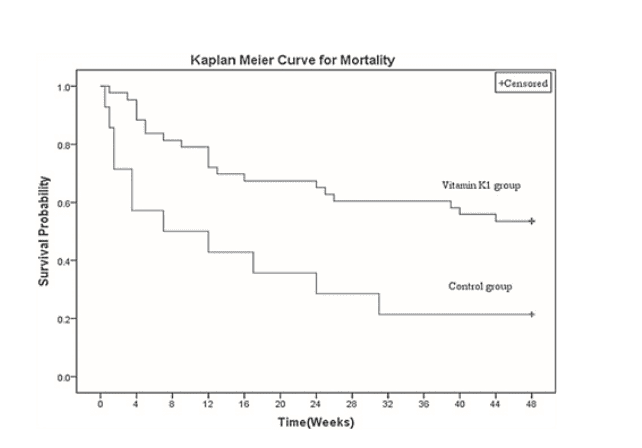
As a result, individuals with severe liver disease are more susceptible to vitamin K deficiency because their liver cannot function properly to produce these essential factors.[16]
Different types of Vitamin K
There are three types of Vitamin K:
Vitamin K1, also known as phylloquinone.
- Predominant form of Vitamin K and used in food supplements and drugs.
- Involved in the process of blood clotting as it activates the proteins that are necessary for coagulation of blood, preventing excessive bleeding.
- Commonly found in dark leafy green vegetables.[1,6]
Vitamin K2, also known as Menaquinone.
- Formed by bacteria, the form of K2 generated is dependent on the strain of bacteria. There are various subtypes of menaquinones, denoted as MK-n, n being the number of isoprene residues. The most important ones are MK-4, MK-7, MK-8, MK-9, and MK-10.
- Involved in bone health, activates osteocalcin (a protein that binds calcium to bones). It also plays a role in cardiovascular health by preventing calcification of arteries.
- Commonly found in cheese and fermented foods.[1,6,17]
Vitamin K3, also known as Menadione.
- Synthetic form of vitamin K.
- Formed in the body as a result of metabolic conversion of phylloquinone (vitamin K1). It is converted into MK-4.
- Commonly used in animal husbandry.[18,19]
Health benefits of Vitamin K
Blood clotting (coagulation)
Vitamin K1, phylloquinone, is necessary for coagulation of blood. This is a process in which the bleeding stops after an injury.[19]
Vitamin K is essential for producing clotting factors II (prothrombin), VII, IX, X, protein C and S. These help to control bleeding and repair damaged blood vessels.[20]
Ensuring sufficient intake of vitamin K1 is particularly important for individuals with certain health conditions or those taking medications that affect blood clotting, as it plays a fundamental role in maintaining the body’s ability to respond to injury and promote healing.
Bone health
Bone density is maintained by vitamin K regulating calcium deposition, activating proteins like osteocalcin, crucial for bone mineralisation.[1]
Vitamin K acts as a cofactor in the conversion of glutamate to Gla. Gla-containing proteins (Matrix Gla-protein and osteocalcin) regulate many anticalcification and bone-forming processes in the body, which are dependent on vitamin K in order to be produced.[21,22]
Bone density is maintained by vitamin K regulating calcium deposition
Low levels of vitamin K impair activation of osteocalcin and decrease the activity of osteoblasts (cells important for building bone).
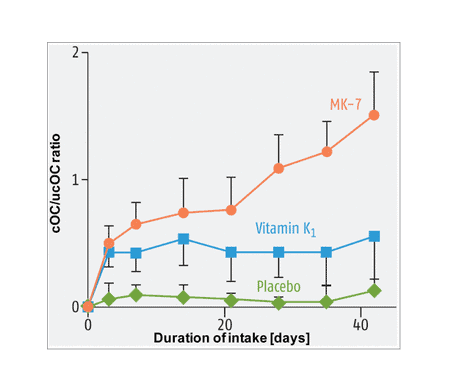
Consuming adequate vitamin K, particularly in the form of MK-7, shows substantial benefits.
Cardiovascular health
Atherosclerosis, a leading cause of cardiovascular disease (CVD), often involves the build-up of calcium deposits in the arteries, which can restrict blood flow and increase the risk of heart attacks and strokes.[23]
Vitamin K2, particularly in the form of MK-7 (menaquinone-7), plays a vital role in preventing this process by activating specific proteins, such as osteocalcin and matrix Gla-protein (MGP).
These proteins help direct calcium to where it is needed in the bones, rather than allowing it to accumulate in the arterial walls.[24]
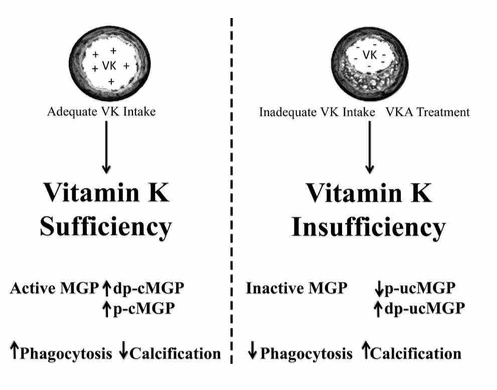
Research has shown that vitamin K2 (MK-7) provides long-term protective effects against vascular calcification by keeping these proteins active.
This not only helps reduce the risk of calcium deposits forming in the arteries but also promotes overall heart health by ensuring proper calcium utilisation throughout the body.[25]
Interplay of vitamin K, vitamin D and calcium
Vitamin K and calcium play a central role in both cardiovascular health and bone health as mentioned above. Vitamin D also plays a crucial role in calcium metabolism.
In cardiovascular health, vitamin K2 activates the MGP, vitamin D facilitates absorption of calcium into the bloodstream and calcium helps regulate heart function.[26,27]
In bone health, vitamin K2 activates osteocalcin, vitamin D enhances absorption of calcium from the intestines and calcium helps bone strength and density.[28]
The synergy between vitamin K, vitamin D and calcium helps to ensure that calcium is effectively absorbed, directed to the bones, and kept out of the arteries to prevent calcification and promote both bone density and cardiovascular health.
Health claims that still need more evidence and research
Protecting cognitive function
Some research has shown that higher levels of serum phylloquinone (vitamin K1) have been positively associated with better performance in verbal episodic memory, which is the ability to recall specific events, situations, and experiences.[29]

It was also found that participants with Alzheimer’s disease had lower intakes of vitamin K than in healthy elders.
Although more research is required, ensuring an adequate intake of vitamin K, whether through diet or supplements, could provide support in individuals at risk of cognitive decline.
Wound healing
Some research has found that topical vitamin K improves wound healing.

In this particular research, vitamin K plays a role in healing wounds and decreasing the wound size.[30]
Skin health
There is some research showing that vitamin K can aid in reducing dark circles, bruising and scars by promoting blood circulation and skin healing.
Research has shown that upon using a dark circle eye pad, both elasticity and pigmentation of dark circles were improved.[31]
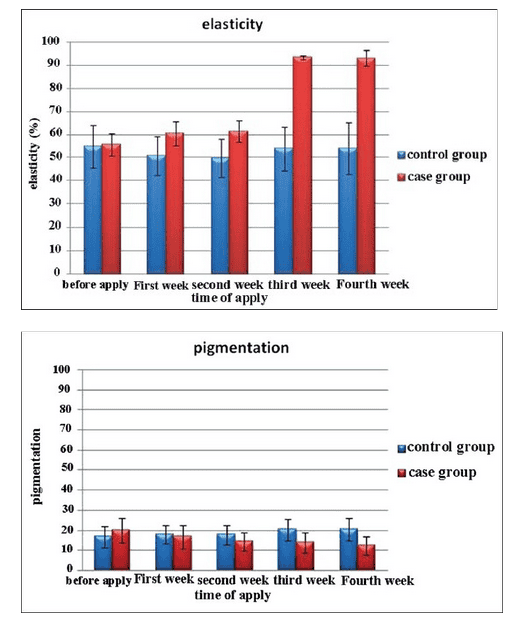
Although this cannot be credited to vitamin K alone, as the eye pad also contained caffeine, therefore, more research is required in order to understand the impact vitamin K has on skin health.
Best sources of Vitamin K
Food Source | Concentration (mcg per 100g) |
Parsley | 1640 |
Natto | 1103 |
Kale | 704.8 |
Spinach (cooked) | 493.6 |
Coriander | 310 |
Watercress | 250 |
Soybean oil | 183.9 |
Green onions | 156.3 |
Broccoli (cooked) | 141.1 |
Brussel sprouts (cooked) | 140.3 |
Lettuce | 126.3 |
Arugula | 108.6 |
Canola oil | 71.3 |
Kimchi | 43.6 |
Veal | 6.6 |
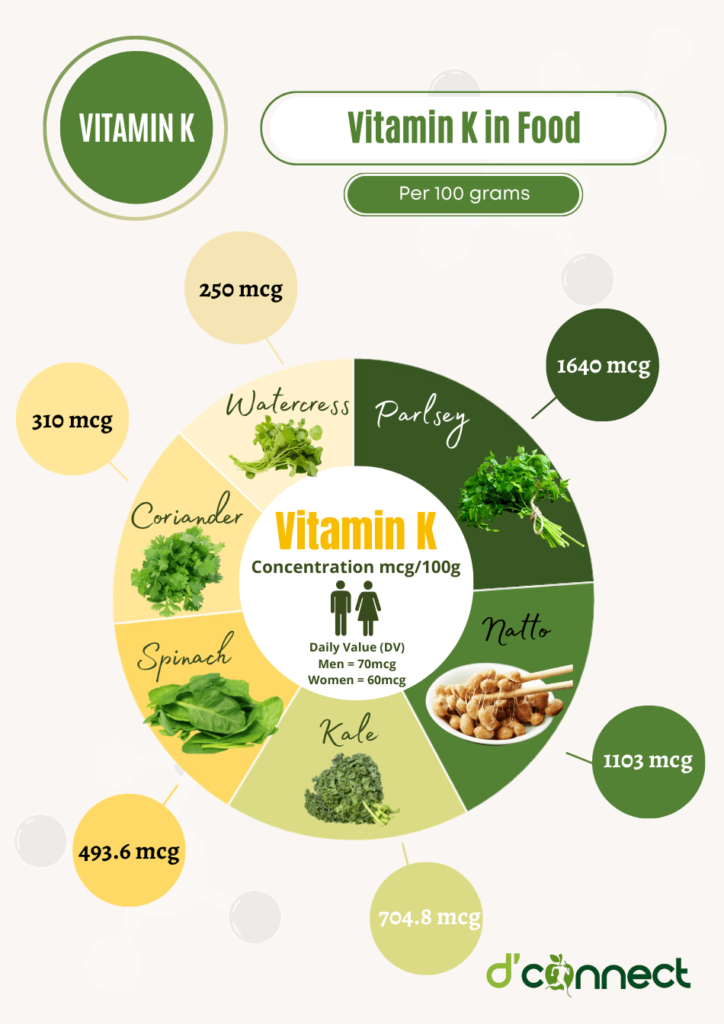
Note — Feel free to download and share this image.
Daily requirements and recommended intake
Age group | Male (mcg/day) | Female (mcg/day) |
Infants (0-6 months) | 2 | 2 |
Infants (7-12 months) | 2.5 | 2.5 |
Children and Adolescents | – | – |
1-3 years | 25 | 150 |
4-8 years | 35 | 200 |
9-13 years | 45 | 45 |
14-18 years | 55 | 55 |
Adults (>18 years) | 70 | 60 |
Pregnancy | – | – |
14-18 years | 60 | |
19-30 years | 60 | |
31-50 years | 60 | |
Lactation | – | – |
14-18 years | 60 | |
19-30 years | 60 | |
31-50 years | 60 |
The daily requirements above are from the Nutrient Reference Values (NRV) for Australia and New Zealand as well as the Ministry of Health.[32]
How to take Vitamin K as a supplement
Since there is no established upper limit for vitamin K intake, determining the safest maximum amount of vitamin K to consume remains uncertain.
Vitamin K is often included in many multivitamin supplements as well as standalone supplements.
There are different types of vitamin K supplements:
- Oral (Powdered, capsules, tablets, liquid)
- Intravenous
- Subcutaneous
- Intramuscular
Vitamin K supplementation may be necessary for some individuals, but typically a balanced diet rich in vegetables is the best way to meet nutritional needs.
Vitamin K supplementation may be necessary for some individuals
It is important to consult and seek guidance from a healthcare professional before incorporating vitamin K supplements into your routine.
Common signs and symptoms of Vitamin K deficiency
Vitamin K deficiency can present in varying symptoms, in which these symptoms can include:
- nose bleeds
- bruises
- vomiting
- jaundice
- sleepiness
Vitamin K risk and side effects
Hypervitaminosis K occurs when excess vitamin K is consumed. Although the body tightly regulates vitamin K levels, and is rapidly metabolised with excess being excreted, toxicity is uncommon.
However, consuming extremely high doses, especially from synthetic forms like vitamin K3 (menadione), could potentially lead to health concerns.[33]
Individuals with certain health conditions, such as liver disease or specific clotting disorders, or those on anticoagulant therapy (e.g., warfarin), excessive vitamin K could interfere with medication efficacy.
Generally, maintaining an appropriate intake of vitamin K through diet or supplements is safe, but high-dose supplementation should be approached with caution, especially in individuals with underlying health issues.
Possible interactions with herbs and supplements
There are certain herbs that should be taken with caution:
- Ginkgo (Ginkgo Biloba)
- Garlic
- Ginseng
- Turmeric (Curcuma longa)
- Ginger[34]
Supplements that can be taken in conjunction with vitamin K:
- Vitamin D (sunshine hormone for stronger bones)
- Calcium (for healthy bones, teeth and heart)
- Magnesium (for a great night of sleep)
- Zinc (for immunity, skin health and libido)
- Collagen
Fish oil has anticoagulant properties and can thin the blood. When taken with vitamin K, which promotes blood clotting, the effects could counteract each other.
It’s advisable to seek guidance or advice from a healthcare professional or dietician before adding any herbs or supplements into your routine.
Possible interactions with medication
There are a few medications that can directly affect vitamin K levels by inhibiting the absorption or the conversion of folate/folic acid into the active form thereby causing deficiency.
RELATED — Vitamin B9 (Folate)
Medication that interact with vitamin K are:
- Anticoagulants: Warfarin (Coumadin), Heparin
- Antibiotics
- Cholesterol-lowering medications
- Anti-Seizure medications: Phenytoin (Dilantin), carbamazepine (Tegretol)
- Chemotherapy agents[35]
All these medications can increase the risk of bleeding, therefore it’s advisable to seek guidance or advice from a healthcare professional or dietician before supplementing with vitamin K.
Summary
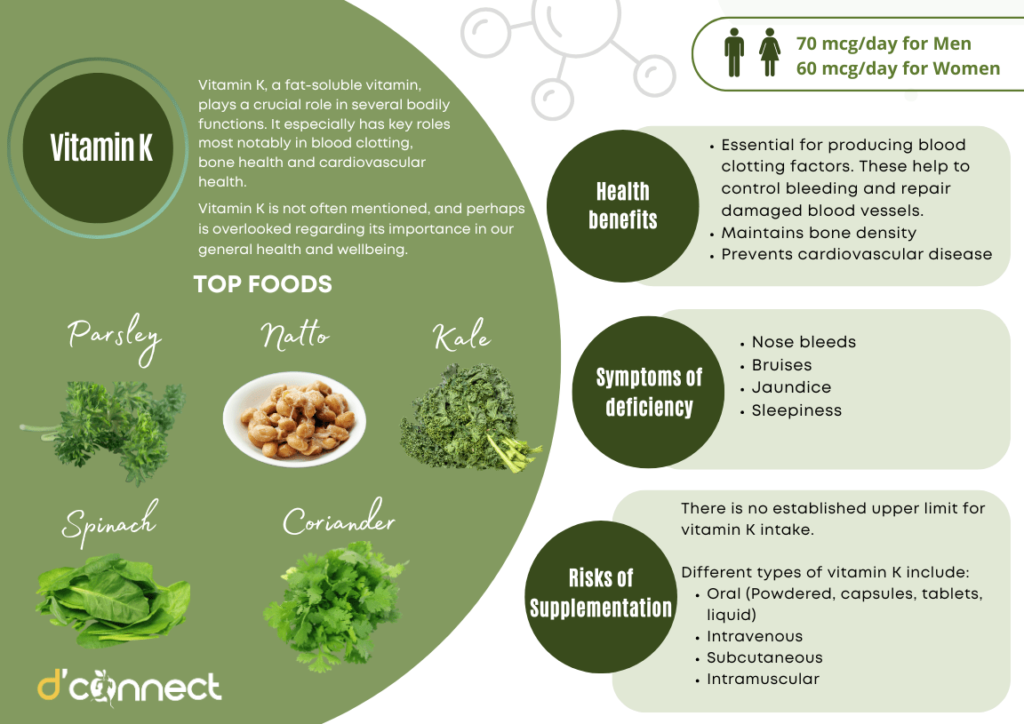
Key Takeaway — In this illustration we have outlined the most important information that you should know about Vitamin K.
Related Questions
1. Is vitamin K good or bad for kidneys?
Vitamin K, particularly K2, supports kidney health by reducing calcification in blood vessels and kidneys, assisting in prevention of chronic kidney disease.
Excessive intake, however, can be harmful.
2. How do I increase vitamin K levels naturally?
To naturally increase vitamin K levels, eat leafy greens (kale, spinach) and fermented foods (natto, kimchi) and cheese.
Maintaining a balanced diet will support overall vitamin K intake.
3. What is the main cause of vitamin K deficiency?
The main cause of deficiency is insufficient dietary intake, due to poor diet or absorption issues.
Malabsorption conditions like celiac disease or prolonged use of certain medications can contribute.
For similar articles on minerals and vitamins, please see our Nutrients section.
Hannah is currently pursuing a Bachelor of Science degree majoring in Nutrition, with aspirations of advancing to Masters in Nutrition and Dietetics in the future. Her academic journey has fueled her interests in childhood nutrition, supplemental nutrition, and the intricacies of nutritional marketing.
References
(1) DiNicolantonio, J. J., Bhutani, J., & O’Keefe, J. H. (2015). The health benefits of vitamin K. Open heart, 2(1), e000300. https://doi.org/10.1136/openhrt-2015-000300
(2) Ferland G. (2012). The discovery of vitamin K and its clinical applications. Annals Nutrition & Metabolism, 61(3), 213-8.
(3) Olson, R. E. (1980). Vitamin K. Nutrition and the Adult. Human Nutrition, 267-286 https://doi.org/10.1007/978-1-4615-7216-9_6
(4) Simes, D. C., Carla S. B. V., Nuna A., et al. (2020). Vitamin K as a Diet Supplement with Impact in Human Health: Current Evidence in Age-Related Diseases. Nutrients, 12(1), 138. https://doi.org/10.3390/nu12010138
(5) Paulus, C. M., Drent, N., Kouw, K. W. I., et al. (2024). Vitamin K: a potential missing link in critical illness – a scoping review. Critical Care, 28. https://doi.org/10.1186/s13054-024-05001-2
(6) Annadurai, A., Delhi K., Praveen, S. M. et al. (2024). Late-onset vitamin K deficiency bleeding: a preventable yet prevailing cause of intracranial hemorrhage in young infants—an ambispective descriptive study. Intensive Care Medicine – Paediatric and Neonatal, 2(2) https://doi.org/10.1007/s44253-024-00028-3
(7) Marchili, M. R., Santoro, E., Marchesi, A. et al. (2018). Vitamin K deficiency: a case report and review of current guidelines. Italian Journal of Pediatrics, 44(36) https://doi.org/10.1186/s13052-018-0474-0
(8) Coffey, P. S., & Gerth-Guyette, E. (2018). Current perspectives and practices of newborn vitamin K administration in low and middle income countries. Research and Reports in Neonatology, 8, 45–51. https://doi.org/10.2147/RRN.S154652
(9) Schulte, R., Jordan, C. L., Morad, A., et al. (2014). Rise in Late Onset Vitamin K Deficiency Bleeding in Young Infants Because of Omission or Refusal of Prophylaxis at Birth. Pediatric Neurology, 50(6), 564-568. https://doi.org/10.1016/j.pediatrneurol.2014.02.013
(10) European Food Safety Authority. (2017). Dietary reference values for vitamin K. EFSA Journal, 15(5), e04780. https://doi.org/10.2903/j.efsa.2017.4780
(11) Lipsky, J. J. (1994). Nutritional Sources of Vitamin K. Mayo Clinic Proceedings, 69(5), 462-466.
(12) Lai, Y., Masatoshi, H., Ma, Y., et al. (2022). Role of Vitamin K in Intestinal Health. Frontiers in Immunology. https://doi.org/10.3389/fimmu.2021.791565
(13) Eden, R. E., Daley, F. S., Coviello, M. J. (2023). Vitamin K Deficiency. StatPearls [Internet].
(14) Mark A. R., Kevin W., Hallgren, L. W., et al. (2018). Warfarin alters vitamin K metabolism: a surprising mechanism of VKORC1 uncoupling necessitates an additional reductase. Blood, 131(25), 2826–2835. https://doi.org/10.1182/blood-2017-09-804666
(15) Gong I. Y., Schwarz U. I., Crown, N., et al. (2011). Clinical and Genetic Determinants of Warfarin Pharmacokinetics and Pharmacodynamics during Treatment Initiation. PLOS ONE, 6(11). https://doi.org/10.1371/journal.pone.0027808
(16) Xiong, Z., Liu, Y., Chang, T., et al. (2020). Effect of vitamin K1 on survival of patients with chronic liver failure: A retrospective cohort study. Medicine 99(13). https://doi.org/10.1097/MD.0000000000019619
(17) Dupuy, M., Radavelli-Bagatini, S., Zhong, L., et al. (2024). Vitamin K1 intake is associated with lower risk for all-cause and cardiovascular disease mortality in community-dwelling older Australian women. Nutrition, Metabolism and Cardiovascular diseases, 34(5), 1189-1197. https://doi.org/10.1016/j.numecd.2023.12.007
(18) Yan, QX., Zhang, T., O’Connor, C., et al. (2023). The biological responses of vitamin K2: A comprehensive review. Food Science and Nutrition, 11.
(19) Kaźmierczak-Barańska J, Karwowski BT. (2022). Vitamin K Contribution to DNA Damage-Advantage or Disadvantage? A Human Health Response. Nutrients, 14(20), 4219. https://doi.org/10.3390/nu14204219
(20) Schwalfenberg G. K. (2017). Vitamins K1 and K2: The Emerging Group of Vitamins Required for Human Health. Journal of Nutrition and Metabolism. https://doi.org/10.1155/2017/6254836
(21) Sim, M., Lewis, R. J., Prince, L. R., et al. (2020). The effects of vitamin K-rich green leafy vegetables on bone metabolism: A 4-week randomised controlled trial in middle-aged and older individuals. Bone Reports, 12. https://doi.org/10.1016/j.bonr.2020.100274
(22) Simes, D., Williamson, M., Schaff, B. et al. (2003). Characterization of Osteocalcin (BGP) and Matrix Gla Protein (MGP) Fish Specific Antibodies: Validation for Immunodetection Studies in Lower Vertebrates. Calcified Tissue International, 74, 170–180.
(23) Hamad, A. H. A., Muhammad, B. I. & Zainab, B., H. Z. (2022). The vascular protective effects of trihoney in hypercholesterolemic atherosclerotic rabbits, a comparative study with atorvastatin. Egyptian Journal of Basic and Applied Sciences, 9(1), 359-371. https://doi.org/10.1080/2314808X.2020.1769913
(24) Vik H. (2019). Highlighting The Substantial Body Of Evidence Confirming The Importance Of Vitamin K2 As A Cardio-Support Nutrient, And How The Right K2 Makes All The Difference. Integrative Medicine: A Clinician’s Journal, 18(6), 24-28. Retrieved from https://www.ncbi.nlm.nih.gov/pmc/articles/PMC7238900/
(25) Halder, M., Ploingarm P., Asim C. A., et al. (2019). Vitamin K: Double Bonds beyond Coagulation Insights into Differences between Vitamin K1 and K2 in Health and Disease. International Journal of Molecular Sciences, 20(4), 896. https://doi.org/10.3390/ijms20040896
(26) Morgan, J. P., Morgan, K. G. (1984). Calcium and cardiovascular function. Intracellular calcium levels during contraction and relaxation of mammalian cardiac and vascular smooth muscle as detected with aequorin. Am J Med.
(27) Nair, R., Maseeh, A. (2012). Vitamin D: The “sunshine” vitamin. J Pharmacol Pharmacother, 3(2), 118-26.
(28) Li, K., Wang X, F., Li, D. Y., et al. (2018). The good, the bad, and the ugly of calcium supplementation: a review of calcium intake on human health. Clin Interv Aging, 28(13), 2443-2452. https://doi.org/10.2147/CIA.S157523
(29) Presse, N., Beleville, S., Gaudreau, P., et al. (2013). Vitamin K status and cognitive function in healthy older adults. Neurobiology of Aging, 34(12), 2777-2783.
(30) Pazyar, N., Houshmand, G., Yaghoobi, R., et al. (2019). Wound healing effects of topical Vitamin K: A randomized controlled trial. Indian Journal of Pharmacology, 51(2), 88-92. https://doi.org/10.4103/ijp.IJP_183_18
(31) Ahmadraji, F., Shatalebi M. A. (2015). Evaluation of the clinical efficacy and safety of an eye counter pad containing caffeine and vitamin K in emulsified Emu oil base. Advanced Biomedical Research, 4(1), 10. https://doi.org/10.4103/2277-9175.148292
(32) Nutrient reference values for Australia and New Zealand including recommended dietary intakes. (2006). Retrieved from https://www.nhmrc.gov.au/about-us/publications/nutrient-reference-values-australia-and-new-zealand-including-recommended-dietary-intakes
(33) Wang, H., Yang, P., Li, L., et al. (2021). Effects of Sources and Forms of Vitamin K3 on Its Storage Stability in Vitamin Premixes or Vitamin Trace Mineral Premixes. Animals, 11(4), 1140. https://doi.org/10.3390/ani11041140
(34) Minno, D. A., Frigerio, B., Spadarella, G., et al. (2017). Old and new oral anticoagulants: Food, herbal medicines and drug interactions. Blood Reviews, 31(4), 193-203. https://doi.org/10.1016/j.blre.2017.02.001
(35) Office of Dietary Supplements. (2022). Vitamin K: Fact sheet for health professionals. National Institutes of Health. Retreived from https://ods.od.nih.gov/factsheets/VitaminK-HealthProfessional/






